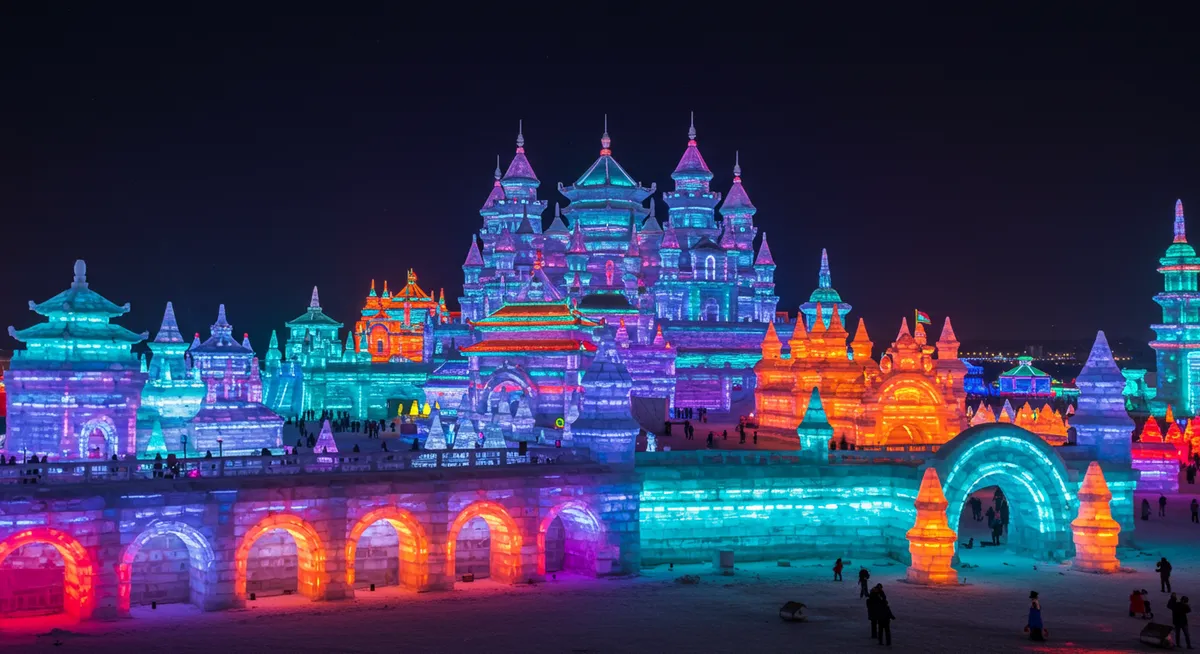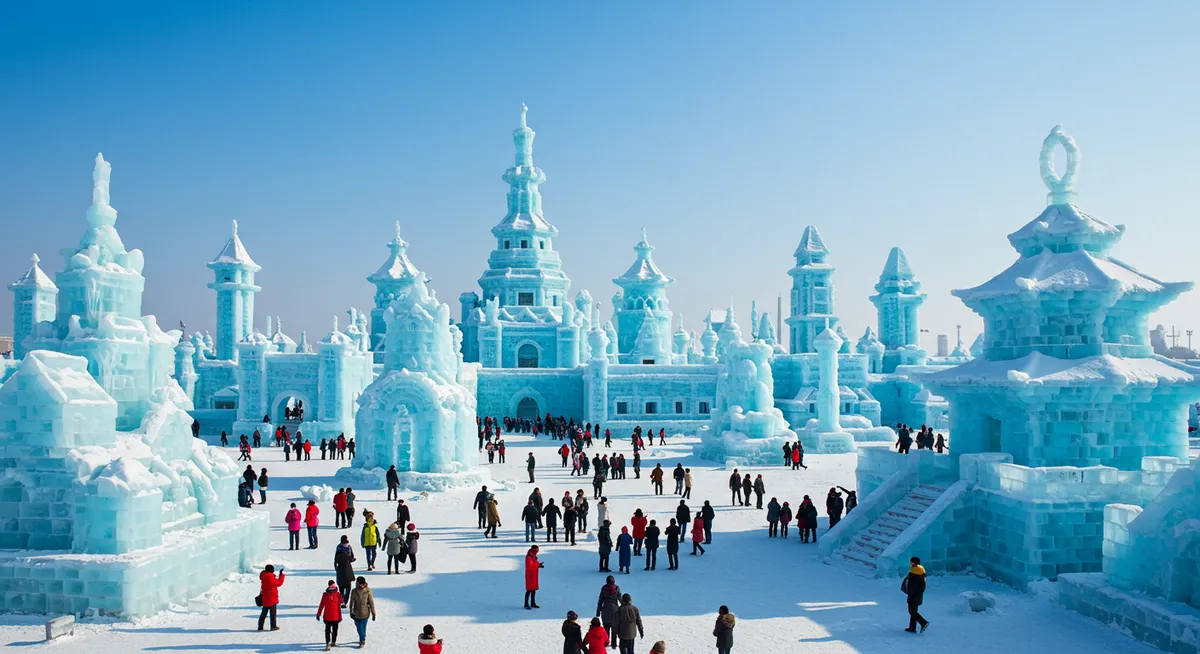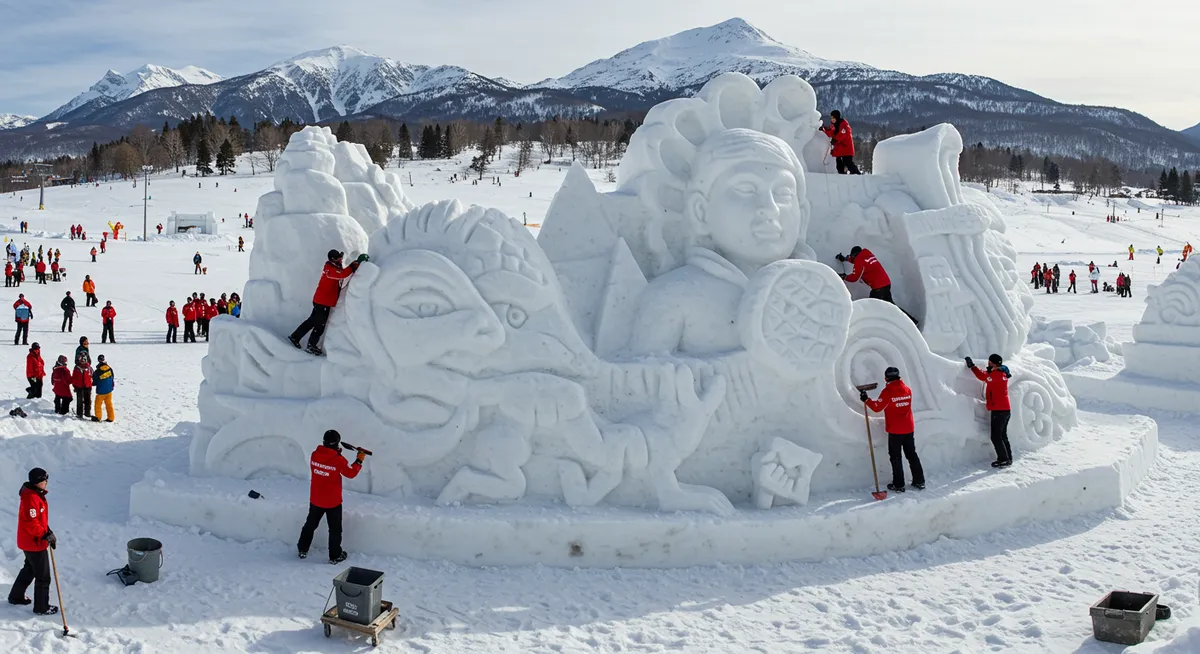Harbin Ice Festival China | World's Largest Ice & Snow Sculpture Event

Harbin Ice Festival: The World's Largest Winter Wonderland of Ice and Light
In the far northeastern reaches of China, where winter temperatures plunge to -30°C (-22°F), the city of Harbin transforms into the world's most spectacular frozen wonderland. The Harbin International Ice and Snow Sculpture Festival stands as the planet's largest winter festival, drawing millions of visitors to marvel at colossal illuminated ice palaces, intricate snow sculptures, and a breathtaking display of artistic innovation that pushes the boundaries of what's possible with frozen water. This extraordinary celebration showcases Chinese cultural heritage while creating a surreal landscape where light, ice, and human creativity combine to produce an unforgettable winter fairytale.

Festival Origins and Evolution
The Harbin Ice Festival's journey from local tradition to global phenomenon spans several decades:
- Historical Roots: Originated from traditional ice lantern displays during the Qing Dynasty when local fishermen created ice lanterns to hold candles during winter fishing
- Official Beginnings: First formally organized as the Harbin Ice Lantern Garden Party in 1963, before evolving into today's grand international festival
- International Recognition: Gained global prominence in the 1980s when the city began inviting international ice sculptors to participate
- Modern Scale: Now covers multiple venues across the city and incorporates advanced technology, architectural innovations, and international competitions
Festival Venues and Spectacular Displays
The festival spans several major locations across Harbin, each offering distinctive experiences:
Harbin Ice and Snow World
The festival's crown jewel features enormous illuminated ice architecture:
- Massive Scale: Covers over 600,000 square meters with structures reaching heights of 50 meters
- Architectural Marvels: Full-sized replicas of famous buildings including palaces, temples, and landmarks from around the world
- Night Illumination: Millions of LED lights embedded within the ice create a kaleidoscopic display after dark
- Interactive Experiences: Ice slides, mazes, and even full-sized restaurants and bars constructed entirely from ice

Sun Island International Snow Sculpture Art Expo
The world's premier snow sculpture competition showcases incredible artistry:
- Monumental Sculptures: Enormous snow masterpieces, some over 30 meters long and 15 meters high
- International Competition: Teams from dozens of countries compete to create the most impressive works
- Artistic Diversity: Sculptures range from classical representations to abstract modern art
- Daytime Viewing: Best visited during daylight hours to appreciate the detailed craftsmanship
Zhaolin Park Ice Lantern Exhibition
The historical heart of the festival showcases traditional Chinese ice art:
- Traditional Ice Lanterns: Showcases the art form that started the festival tradition
- Intricate Carvings: Features the most detailed and delicate ice artworks
- Cultural Themes: Displays often depict Chinese folk tales, zodiac animals, and historical scenes
- Family Friendly: Smaller scale makes it ideal for visitors with children
Harbin Central Street (Zhongyang Dajie)
The city's historic pedestrian thoroughfare becomes an ice gallery:
- Street Exhibitions: Smaller ice sculptures line the 1.5km Russian-influenced street
- Ice Bars: Pop-up venues serving hot drinks in ice glasses
- Winter Markets: Vendors selling traditional northeastern Chinese winter specialties
- Architectural Context: Beautiful European-style buildings from the early 20th century provide a distinctive backdrop
Construction and Artistic Process
Creating the festival's frozen masterpieces requires extraordinary skill and resources:
Ice Harvesting and Construction
The massive building process begins months before visitors arrive:
- Songhua River Source: Over 180,000 cubic meters of ice are harvested from the frozen Songhua River
- Crystal Clear Blocks: The highest quality blocks, measuring 1m × 2m and weighing up to 700kg, are prized for their clarity
- Construction Teams: Thousands of workers spend weeks cutting, hauling, and precisely stacking the ice blocks
- Engineering Innovation: Steel frames often provide internal support for the largest structures
Artistic Techniques
The creation of sculptures employs both traditional and innovative methods:
- Chainsaw Rough Cutting: Initial forms emerge through skilled chainsaw work
- Detailed Carving: Fine details created with specialized chisels and tools
- Surface Finishing: Techniques using heat, water, and special tools create different textures and transparency effects
- Colored Ice: Dyes and food coloring incorporated to produce multi-colored sections

Lighting Technology
The festival's magical nighttime appearance comes from sophisticated illumination:
- LED Integration: Millions of energy-efficient lights are embedded within or placed behind the ice
- Programmable Systems: Computerized lighting sequences create dynamic color changes and effects
- Ice as Conductor: The natural properties of ice diffuse and soften light, creating a magical glow
- Projection Mapping: Advanced techniques project moving images onto ice surfaces
Experiencing the Festival as a Visitor
Attending this extraordinary event requires preparation for extreme conditions:
Practical Travel Information
Essential knowledge for planning your Harbin adventure:
- Festival Dates: Typically runs from late December through late February, with official opening around January 5
- Peak Viewing: Mid-January offers the best combination of completed sculptures and preserved condition
- Temperature Preparation: Average temperatures range from -13°C to -24°C (8°F to -11°F), with extremes reaching -30°C (-22°F)
- Venue Hours: Ice and Snow World opens from 9:00 AM to 9:30 PM, with evening hours (after 5:00 PM) offering the magical illuminated experience
Winter Survival Tips
Staying comfortable in extreme cold requires specialized preparation:
- Layering Strategy: Multiple thin layers under quality thermal outerwear, with special attention to insulated footwear
- Face Protection: Balaclavas or scarves to cover exposed skin, especially for protection from wind
- Hand and Foot Warmers: Chemical heat packs provide additional warmth for extremities
- Indoor Retreats: Plan regular warming breaks in heated rest areas throughout the venues
- Camera Care: Special considerations needed for photography equipment in extreme cold
Beyond the Ice
Harbin offers complementary winter experiences beyond the main festival:
- Siberian Tiger Park: The world's largest Siberian tiger breeding facility showcases these magnificent animals in their natural winter habitat
- Winter Swimming: Witness the extraordinary Harbin winter swimmers who break holes in the frozen Songhua River for daily dips
- Russian Architecture: Explore the city's unique blend of Chinese and Russian influences, especially St. Sophia Cathedral
- Northeastern Cuisine: Sample hearty regional specialties perfect for winter, including dumplings, hot pot, and grilled meat skewers
Cultural Significance and Global Impact
The festival represents far more than a tourist attraction:
Seasonal Celebration
For northeastern China, the festival transforms harsh winter into a season of celebration:
- Winter Resilience: Celebrates the ability to thrive in extreme conditions that once made the region nearly uninhabitable
- Natural Resource: Transforms the region's challenging climate into an economic and cultural asset
- Seasonal Spirit: Creates a focal point of communal celebration during the coldest months
- Ice Harvesting Tradition: Honors the historical practice of ice collection for year-round refrigeration
Economic Impact
The festival generates tremendous benefits for the region:
- Tourism Revenue: Attracts over 15 million visitors annually, generating billions in economic activity
- International Visibility: Positions Harbin as a global winter tourism destination
- Seasonal Employment: Creates thousands of jobs in construction, hospitality, and services
- Year-round Benefit: Has helped develop infrastructure that benefits the city beyond the festival season
Planning your Harbin Ice Festival visit
For the optimal experience, plan to visit in mid-January when all sculptures are complete and at their most pristine. Allow at least two full days to properly experience all major venues.
The festival is best enjoyed by spending daylight hours at the Snow Sculpture Expo, then experiencing the magical illumination of Ice and Snow World after dark.
Explore More Asian Cultural Festivals
If you're fascinated by the Harbin Ice Festival, discover other extraordinary Asian celebrations that showcase the continent's rich cultural heritage:
Wakakusa Yamayaki
Japan's dramatic mountain burning festival with ancient origins and spectacular night views.
Sapporo Snow Festival
Japan's famous winter celebration featuring monumental snow sculptures and ice art.
Vesak: Buddha Day
Buddhism's most sacred festival celebrating Buddha's birth, enlightenment, and passing.
Naadam Festival
Mongolia's national celebration featuring traditional wrestling, archery, and horse racing.
Dragon Boat Festivals
Ancient East Asian celebrations with thrilling boat races and rice dumplings.
Holi Festival
India's vibrant spring festival with colorful powder celebrations.
Return to our Asian Cultural Festivals Guide to discover more extraordinary celebrations across the continent.